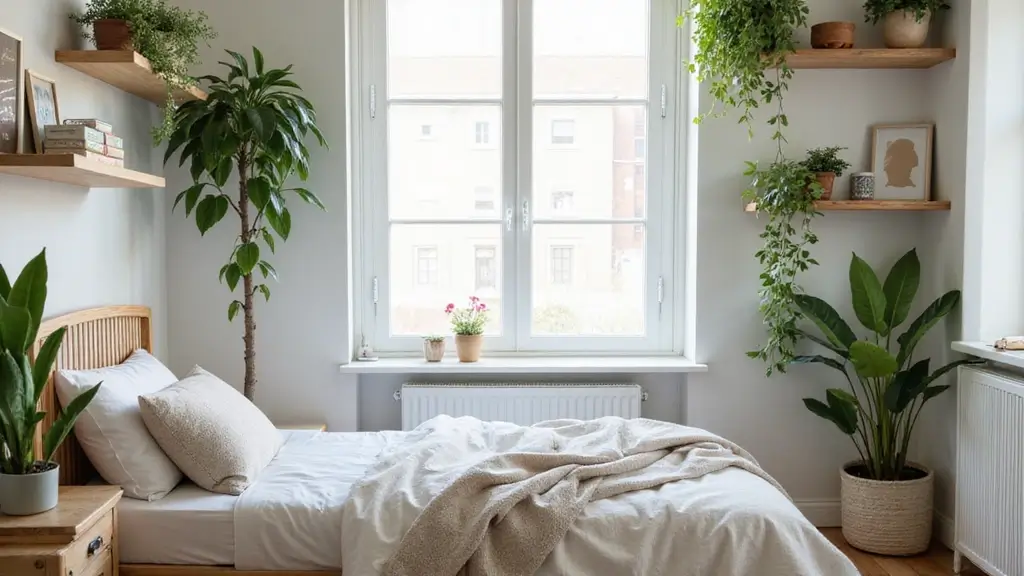I made this post because tiny bedrooms often feel cramped and messy. Here is why this matters: you want a space that relaxes you, not a room that fights for attention. I want to help you turn a small room into a calm, usable space. So I pulled together 30 Bedroom Set Up Ideas That Make Small Rooms Feel Big that show practical ways to stretch every inch.
If you live in a small apartment, share a room, or just love smart design that doesn’t break the bank, this one’s for you. You care about space that looks clean and feels open. You want ideas that work in real life, not just pretty pictures.
Here’s what you’ll get. Let’s break it down: layout tricks, color ideas, lighting, storage, and furniture choices. These ideas are practical, budget friendly, and easy to test in your own room. You’ll see how small shifts—a low bed, floating shelves, or a mirror—can make a room feel twice as big.
These tips work with real spaces. They rely on vertical space, light colors, and simple lines to reduce clutter. They help you build a calm baseline that makes any furniture you love fit without crowding the room.
Start with a quick plan. Measure your room and mark doors, windows, and outlets. Test ideas with tape on the floor before moving furniture. Take it one step at a time. Next steps: pick one idea and try it this week.
Ready to dive in? Pick one idea and test it this week. I’d love to see your space in the comments or with a photo tag. If a room has poor light or odd corners, these ideas can still help, but you may need a few bigger fixes.
1. Floating Shelves for Storage and Style
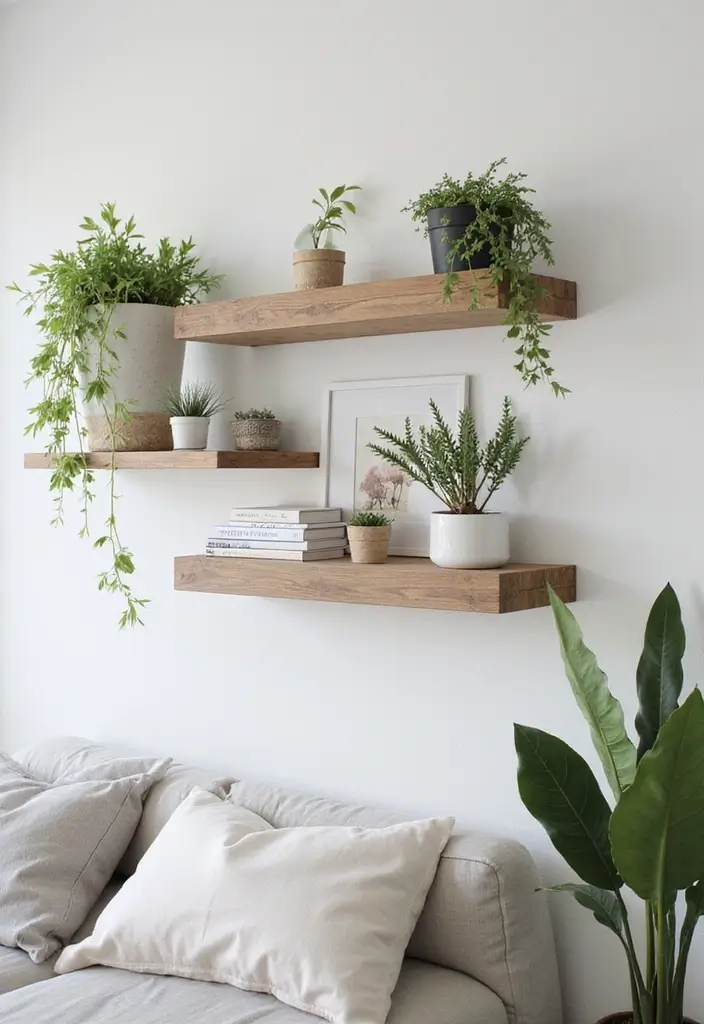
If your bedroom is tight on space, floating shelves can be your best friend. They give you storage and style without stealing floor space. You get a place for books, plants, photos, and keepsakes that would clutter a dresser. They turn a dull wall into a go-to display.
Here is why they work. They make the room feel bigger because the walls carry the weight of your belongings, not the floor. They set up a mini display that draws the eye upward and creates depth.
– Choose slim shelves in wood or metal for a clean look. Pick finishes that match your decor.
– Vary heights and widths. A tall stack with short units forms a wall gallery.
– Put shelves where you use items often. Balance open spaces with what you show.
– Add baskets or boxes. They hide cords and clutter.
– Add a small LED strip under a shelf for warmth at night.
Tips: Mount brackets in a color close to your wall. Don’t crowd the shelves; give each item room to breathe.
Next steps: Measure the wall, sketch a layout, and install with basic anchors. Start small and add shelves as needed.
With a few careful moves, you can refresh the whole room. Start with one small set and grow as you gain ideas.
When space is tight, think vertical! Floating shelves are your stylish solution, turning walls into displays and making small bedrooms feel big. Embrace the upward trend for a clutter-free haven!
2. Multi-Functional Furniture to Maximize Space
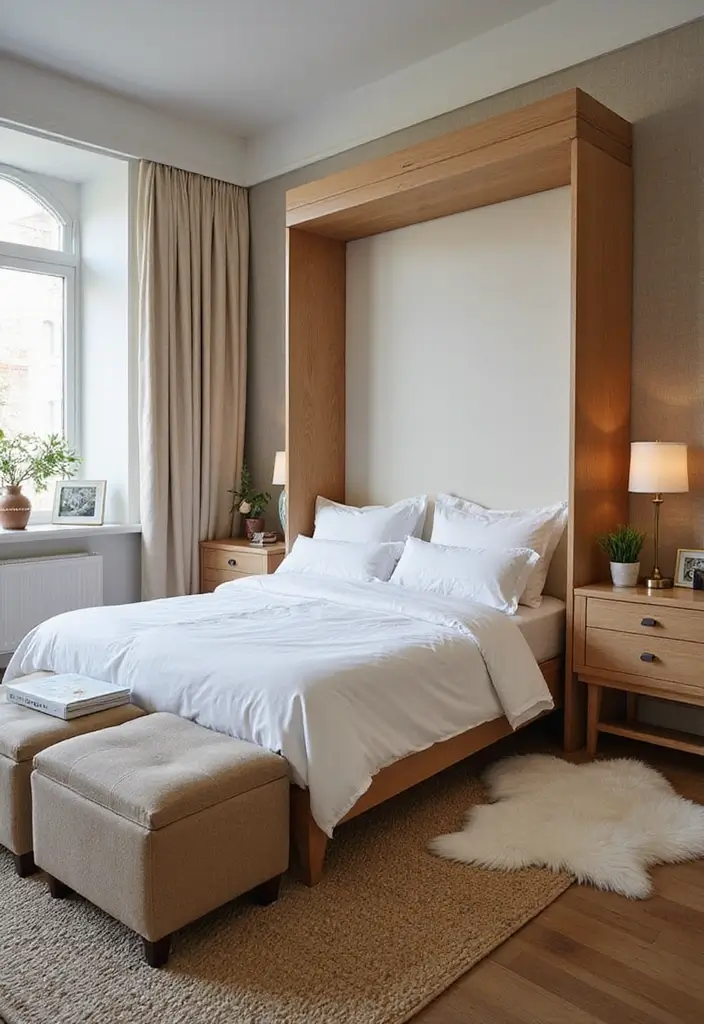
If your small bedroom feels tight, smart furniture can change the space. You can lose clutter and gain air around you. This guide shows multi-functional pieces you can trust in a compact room.
– Storage beds with drawers: A bed frame that hides clothes, blankets, or toys cuts down on extra furniture. Look for lids or panels that lift easily and drawers that glide. Check ceiling height and mattress size so the bed fits cleanly.
– Ottomans and benches with hidden storage: A padded ottoman at the foot of the bed or a small bench can store shoes, extra sheets, or remotes. Pick light or neutral colors to keep the room feeling open.
– Fold-out desks for small work zones: A desk that folds against the wall frees floor space when you are not working. Use it for a laptop, lamp, or notebook. Place it where the light hits best.
– Murphy beds for day time floor space: A wall bed folds away at daybreak and comes down at night. Check ceiling height and room for a mattress. Shelves above can hold books or a clock.
– Tie it together with a single color: Choose furniture in the same hue or finish. A cohesive look makes the room feel bigger and calmer.
Next steps: measure your room, set a budget, and pick two space-saving pieces to start.
3. Light Colors for a Spacious Atmosphere
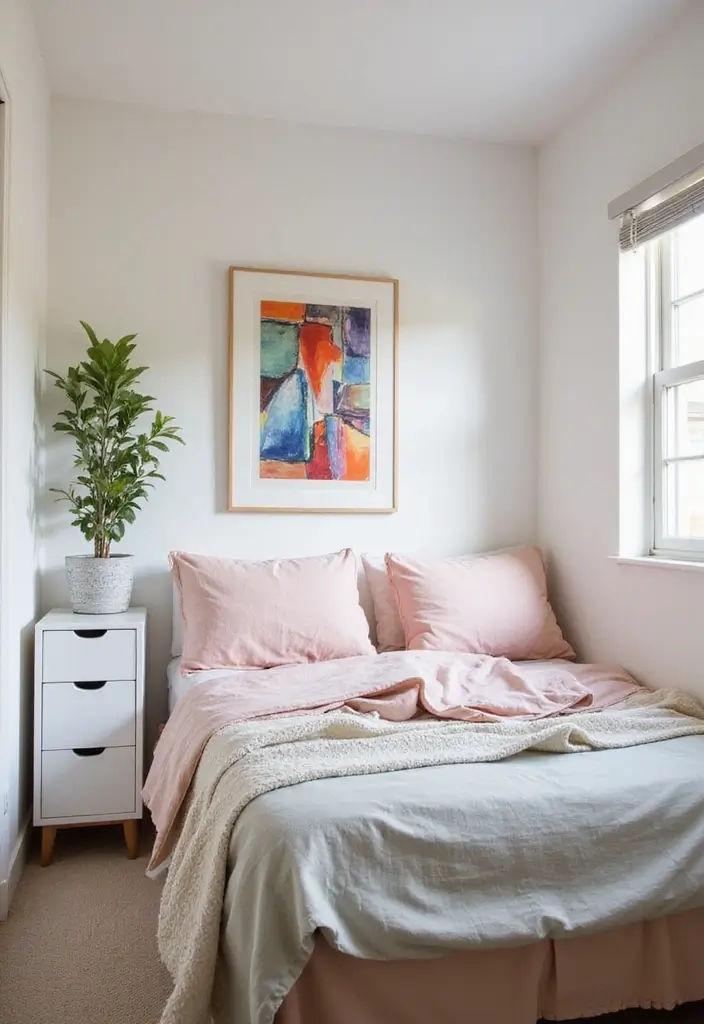
Want a bedroom that feels bigger? Start with light colors. Soft whites and pale pastels bounce light around the room. That bright, open vibe comes from the color you choose.
Here is why it works: light tones reflect more light and keep surfaces looking clean. With less contrast, the eye roams freely and the space feels calm and roomy.
– Base color: pick a soft white, ivory, or pale gray for the walls. Keep the ceiling light too.
– Accent wall: choose one wall and apply a shade that is just a notch darker. This adds depth without crowding the room.
– Bedding: go with light sheets and a thin blanket in white or a gentle pastel. It preserves airiness while still feeling snug.
– Decor: bring in color with a few art prints or cushions. Limit to 2–3 pieces in soft tones so the room stays airy.
– Lighting: use warm white bulbs. They keep the space welcoming rather than stark.
Next steps to implement:
– Decide your base color and the accent wall shade.
– Choose bedding in light hues that match the walls.
– Pick a couple of art pieces or pillows in one or two soft colors.
– Keep clutter low so the light can travel freely.
With these moves, your small room gains depth, brightness, and a more spacious feel.
4. Vertical Storage Solutions
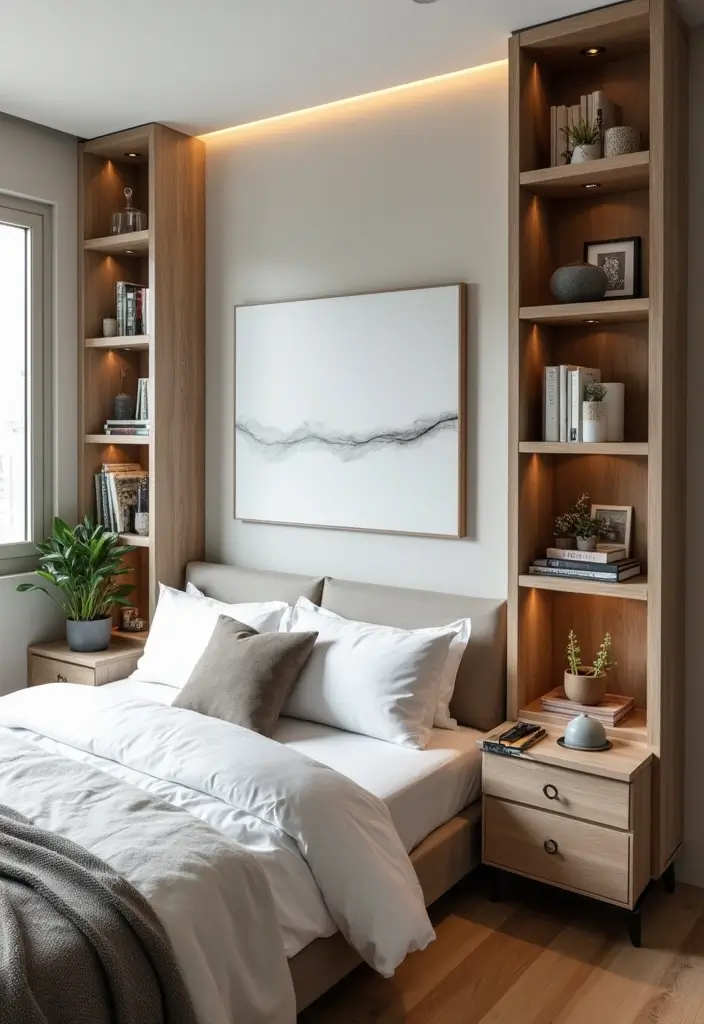
Small bedrooms feel tight. Here is why vertical storage helps. It frees floor space and keeps daily items within reach.
– Tall, slim bookcases keep books off the floor without crowding. Place one beside the bed or next to a dresser for a neat storage corner.
– Narrow wall cabinets fit along tight walls or behind doors. They hide clothes, towels, and gadgets behind quiet doors.
– Wall hooks for everyday items hang bags, hats, or jewelry. Put them at eye level so you use them daily.
– Pegboard above your desk offers a flexible rack for cords and tools. Add simple hooks and a small tray for tiny items.
– Under-bed storage uses flat bins or rolling drawers. Slide seasonal clothes or extra linens there.
– Floating shelves add spots for books, plants, or a clock. Mount them where you can reach without crowding the room.
Start with one idea and test how it feels. Vertical storage clears floors and makes a small room feel more open. These simple steps add up to a space you can enjoy daily. Try a small shelf this week.
5. Mirrors to Create Illusion of Space
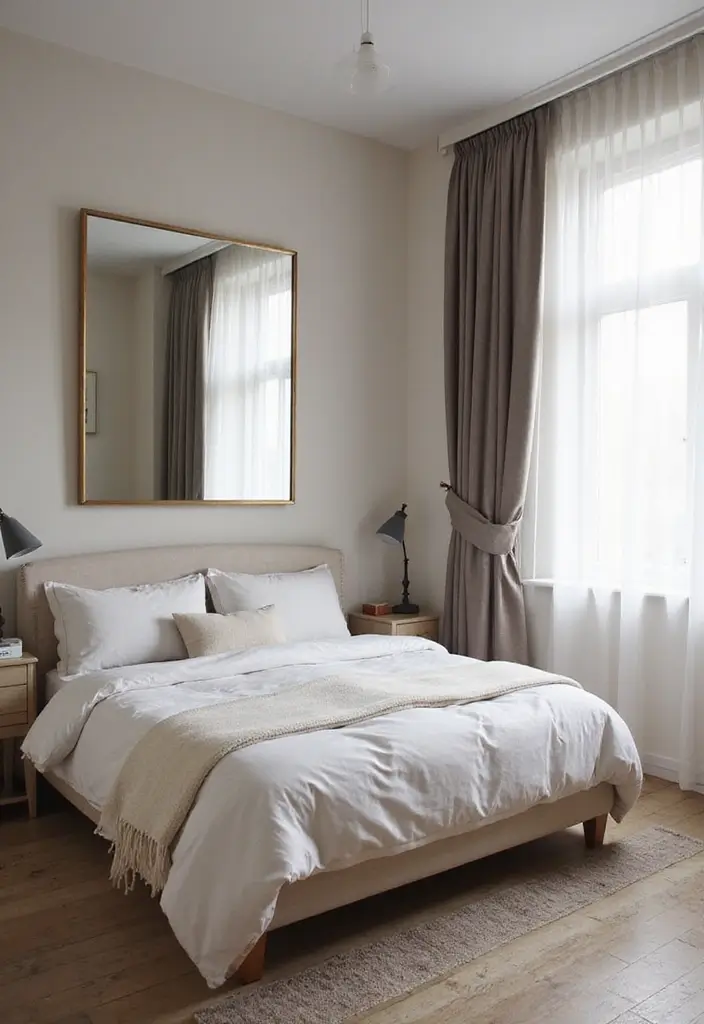
Small bedrooms can feel tight. Mirrors are a simple fix that buys space. You can use them in smart ways to make the room look bigger and brighter. Here is how to do it.
– Large wall mirror: Hang a tall mirror on one wall. The glass reflects the room and adds depth. You’ll see more space in the reflection, and light travels farther.
– Mirrored furniture: Try a dresser, nightstand, or vanity with a mirrored finish. It reflects lamps and daylight, adding shine without extra clutter.
– Unique Insight: Place mirrors opposite windows. This doubles the natural light and makes the ceiling feel higher.
– Frames that fade: Choose slim, light frames or go frameless. Subtle borders keep the wall from looking crowded.
– Light together: Pair mirrors with soft lighting. A warm glow bounces between the glass and the walls, brightening corners.
– Easy placements: If you don’t want a wall mirror, lean a tall mirror against a wall or use a slim floor mirror by the bed. It still widens the space.
Next steps: pick one mirror idea to start, then add another as the room settles. With careful placement, your small bedroom will feel more open and welcoming.
6. Wall-Mounted Lighting

If you want more space on the nightstand but still bright enough, wall-mounted lighting helps. It lights your bed area without crowding surfaces.
Here is why it works. Sconces pull light right where you need it. They give you a clean look and a strong reading light in one piece. You stay neat, and you get the glow you want.
Tips to pick and place
– Choose adjustable sconces. A swing arm helps you aim light for books or late-night snacks.
– Pick dimmable lamps. You can brighten for tasks or soften for movie nights.
– Match your style. Brass feels warm and classic; matte black reads modern. Glass or fabric shades add texture.
Placement
Install each fixture about arm’s reach from the bed and roughly at eye level when you sit up. If you hit a stud, anchor there. If not, use the right wall anchors. Hide cords with bed frames or cord clips.
Practical use
Use one light for reading and another for ambient glow. This combo keeps the room balanced. Pair with a soft ceiling light or a floor lamp for extra depth. Wipe the metal with a soft cloth to keep it looking fresh. Your space will feel bigger and calmer.
7. Layered Textures for Depth
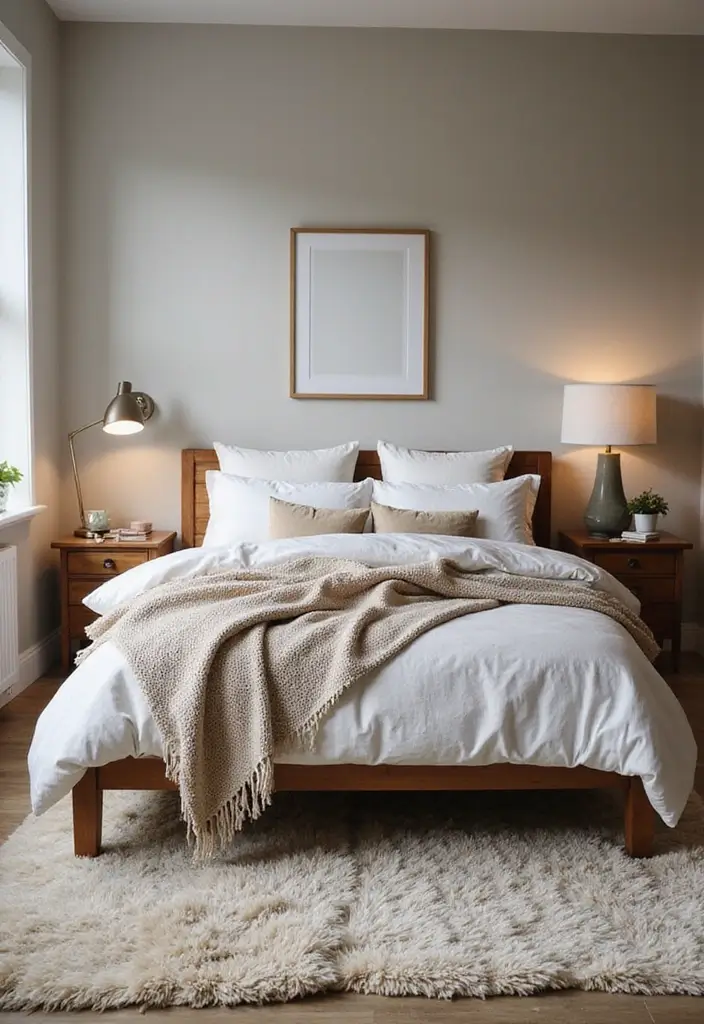
You want a small bedroom that feels inviting, not cramped. Layering textures helps you get depth without more furniture.
– A plush throw draped over the foot of the bed.
– A soft rug that peeks from under the sides.
– Bedding with two or three fabrics, like cotton sheets, a linen duvet, and a velvet or knit cushion.
Tips: Pick two or three textures and two or three colors. Keep the tones close so the look stays calm.
Next steps: choose your materials. Cotton, linen, wool, velvet, and faux fur all read differently under light. Place a long rug under the bed so it shows on both sides. Fold a thick throw at the end of the bed for a comfy spot to touch. Mix patterns in small repeats, like a thin stripe with a solid, or a tiny geometric with a solid in the same color family.
This approach adds depth and warmth, which makes the room feel bigger. It also softens hard edges and draws the eye around the space. Keep care simple: wash fabrics as needed, rotate a couple of textures seasonally, and store extra pieces out of sight when not in use.
Start today and tweak as you go.
8. Compact Desks for Workspaces
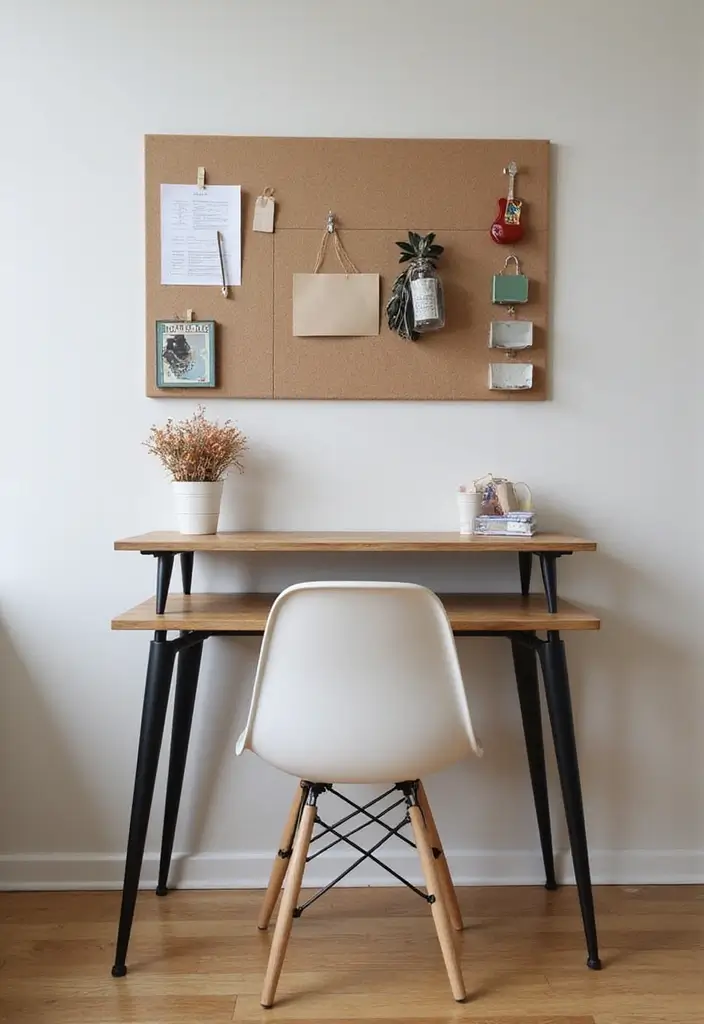
If you need a workspace in a small bedroom, you want a desk that fits without crowding the room. A compact desk keeps your path clear and your bed the focus. Here is why compact desks work well in small rooms. Let’s break it down into practical options you can set up this weekend.
– Slim writing desk — Choose a desk that sits flush on a wall. Aim for a depth around 12 to 18 inches to keep floor space open.
– Foldable desks — A fold-down desk tucks away when not in use. Mount it with solid brackets secured to studs for stability.
– Wall-mounted desk — A fixed wall desk floats above the floor and keeps legs out of the way. It creates a clean, airy feel.
– Rolling desk — A small rolling cart acts as a desk and can slide into a corner when you don’t need it. Pick one with a drawer for small supplies.
– Vertical organizers — Use slim wall shelves and vertical file racks to clear the desk top. Less clutter means more focus.
– Pinboard or whiteboard — Mount a board above the desk for notes and ideas without taking up desk space.
– Cable management — A simple cable tray keeps cords neat and out of sight. It makes the area feel calmer.
– Lighting and color — Choose light colors and a compact LED lamp to brighten the area without crowding it.
Next steps: measure your space, compare these options, and pick one that fits your layout and routine.
9. Use of Rugs to Define Areas
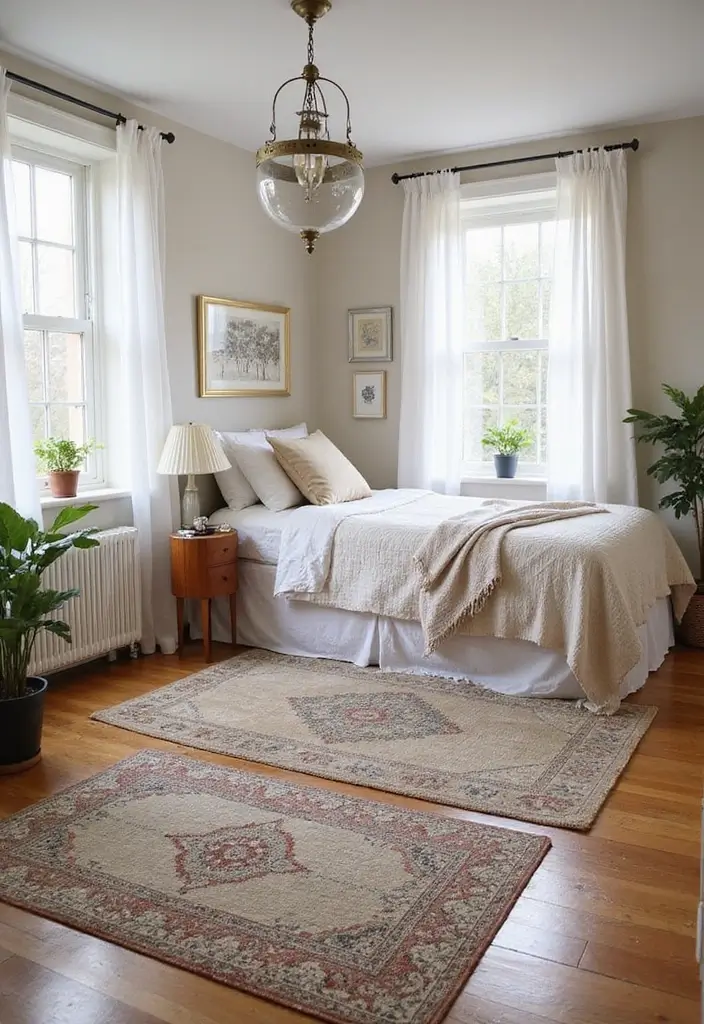
Small rooms need clear zones, not more walls. Rugs can carve out places without clutter. You can set up a bed area, a reading corner, and a workspace that feel separate yet part of one room.
A large rug under the bed acts as a soft anchor. It creates a warm center you can see from anywhere in the room. Leave a bit of floor showing on all sides so the rug looks intentional, not crowded.
Smaller rugs help you map other zones. Put a rug beside a chair to mark a comfy reading nook. Add another near a desk to define a workspace. The goal is simple: create visual anchors that guide your eye and your feet.
Why light colors matter and soft textures keep the space airy. Light rugs reflect light and make the room feel bigger. Choose wool, cotton, or blends that feel good under bare feet. Steer away from busy patterns that fight with your wall color.
Shapes count too. A rectangular rug fits a long bed well. A round rug can soften sharp corners and add a friendly vibe.
Layering can add depth, if you like. Start with the big rug, then place a smaller one in lounge spots. Use a non slip pad to keep rugs in place.
Placement tips are practical. Let rug edges align with furniture edges. Keep enough rug visible so the floor still reads as part of the room.
Next steps: measure your space, pick two rugs plus a small runner, and lay the big rug first. Then add the other rug and adjust until it feels balanced. Finally, vacuum regularly and rotate rugs to wear evenly.
10. Canopy Beds for Vertical Interest
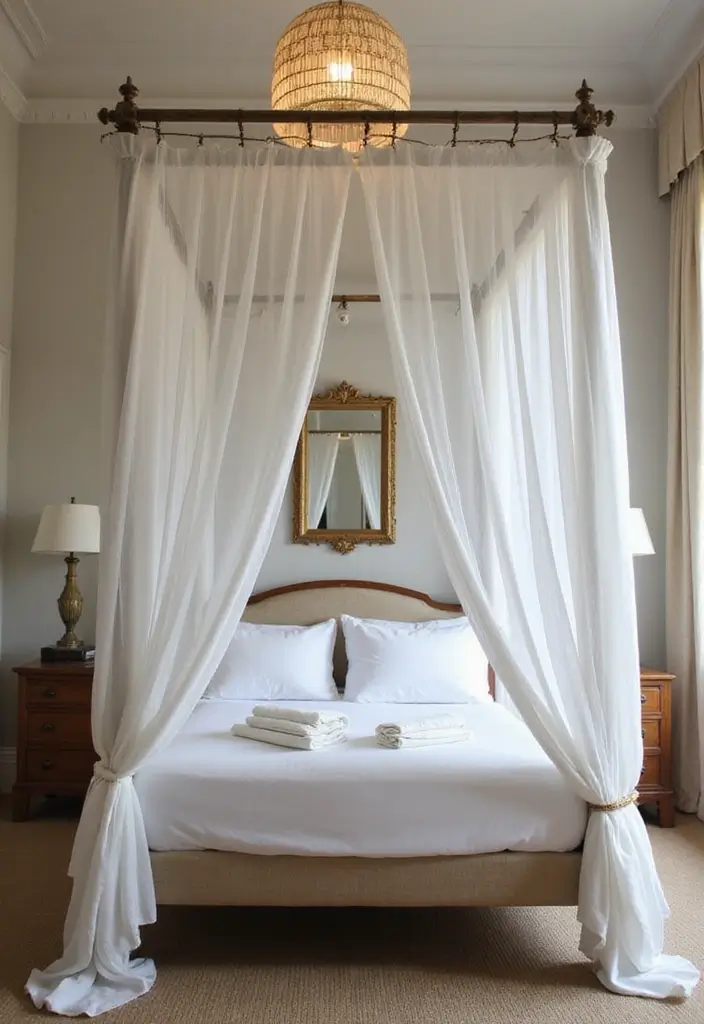
If your bedroom is small, you want style without wasting floor space. A canopy bed adds height and elegance without stealing room.
Here is why it helps. Your eyes go up, so the walls feel farther away. The vertical lines make the room look bigger and calmer.
Let’s break it down with simple steps you can try soon.
– Choose airy drapes that let light filter through. Sheer voile or light cotton work well.
– Pick fabrics in soft colors. White, ivory, pale gray, and pale blue stay bright.
– Use a slim frame or metal posts. Clean lines keep the look light.
– Let the canopy stay light. Avoid thick borders that feel heavy.
– Keep the bed simple. A neat duvet and plain sheets do the job.
Tips: A calm palette helps the canopy stand out without taking over.
Next steps to implement:
– Measure your ceiling height and space to pick the right height and pole length.
– Decide on color and fabric, then buy a light canopy kit or fabric panels.
– Install the posts and hang the drapes so they flutter softly in the breeze.
With these moves, you gain vertical drama and space that still feels cozy. This simple setup makes the room feel bigger and cozier.
Elevate your space with a canopy bed! It draws the eyes upward, making your small bedroom feel spacious and serene. Choose light fabrics and soft colors for an airy charm that maximizes vertical space.
11. Custom Cabinetry to Maximize Storage
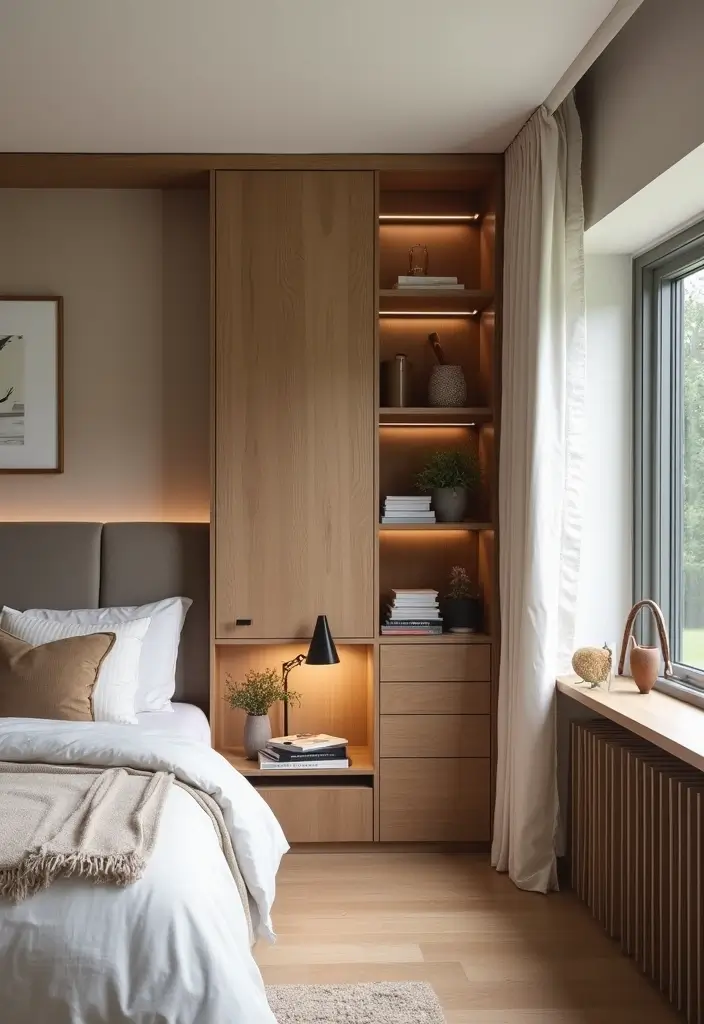
If your bedroom feels tight, custom cabinetry can help you win space without losing style. Built-ins fit awkward corners and tuck under sloped ceilings, giving you storage for clothes, shoes, and more. Each piece is made for your space, so you get the depth and height. Here is why this works in small rooms.
Smart ways to use built-ins:
– A tailored fit hugs the wall, leaving the center open for movement.
– A multi-use design acts as clothing storage, a display shelf, and a hidden charging station.
– Light finishes keep the area feeling airy rather than cramped.
Practical ideas to add now:
– A pull-out desk slides out for work and slides away when you’re done.
– A fold-down surface can serve as a nightstand or study table and folds flat when not in use.
Materials and style tips:
– Choose light wood like maple or birch or stick to white paint for brightness.
– Opt for simple doors with small or hidden handles to reduce bulk.
– Keep lines clean with a slim profile to maintain an open look.
Planning tips:
– Measure the wall, note the ceiling slope, and mark outlets.
– Plan zones: hanging space, drawer storage, and a display area.
Next steps: sketch a rough layout and talk to a carpenter about custom cabinet options.
Custom cabinetry isn’t just smart storage; it’s a style statement! Transform tight corners into functional displays that breathe life into your small bedroom. Embrace built-ins for a clutter-free, stylish sanctuary!
12. Use of Vertical Plants for Freshness
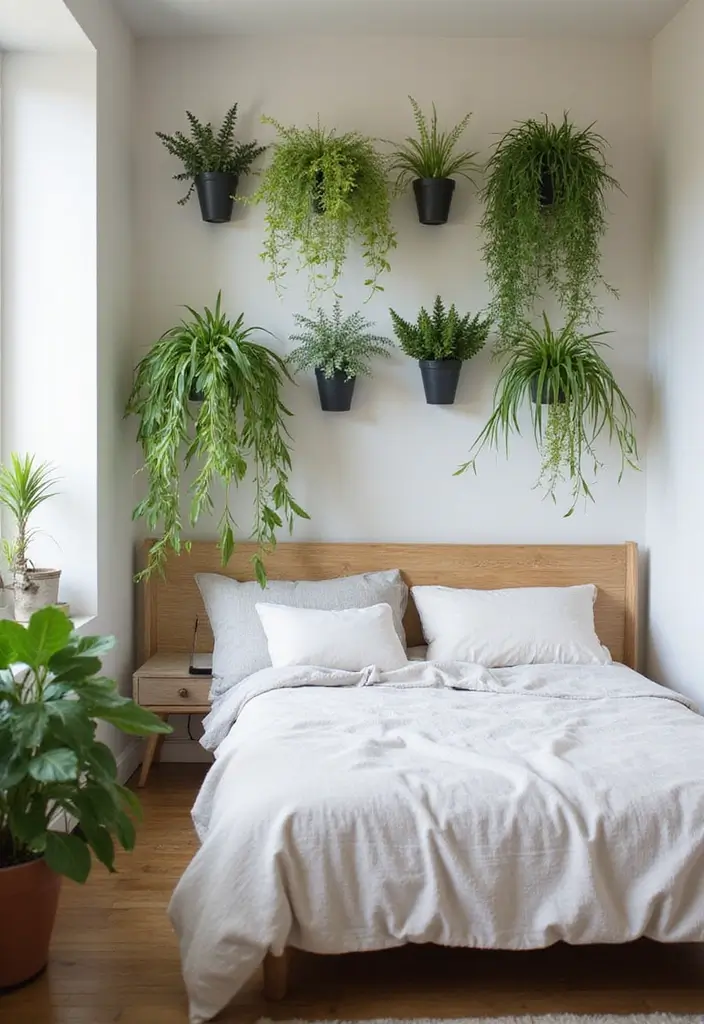
Small rooms can feel cramped. Vertical plants fix this. They bring color and life without crowding the floor. Pick a spot near a window so light hits them. A small shelf or wall planter can hold two or three pots. This makes the wall a feature, not a dead space.
Here is how to set it up. You can use wall-mounted planters on any free wall. Or hang pots from a ceiling hook above your bed or chest. Choose trailing plants to fill space softly. This keeps desks and dressers clear.
Low-maintenance options work best. Pothos, spider plant, and ZZ plant are sturdy choices. They bounce back when you forget to water once in a while.
Care tips help them last. Use lightweight planters to prevent wall stress. Water slowly and let the soil dry a bit between drinks. Place plants where they get bright but indirect light. Rotate them every few weeks so they grow evenly.
The payoff shows fast. Plants lift mood and smell clean. They also make the room feel more open and calm.
Quick setup guide
– Measure the wall you want to use.
– Pick planters that fit your style and space.
– Install securely and test for weight.
– Rotate plants as seasons change.
13. Colorful Accents for Personality
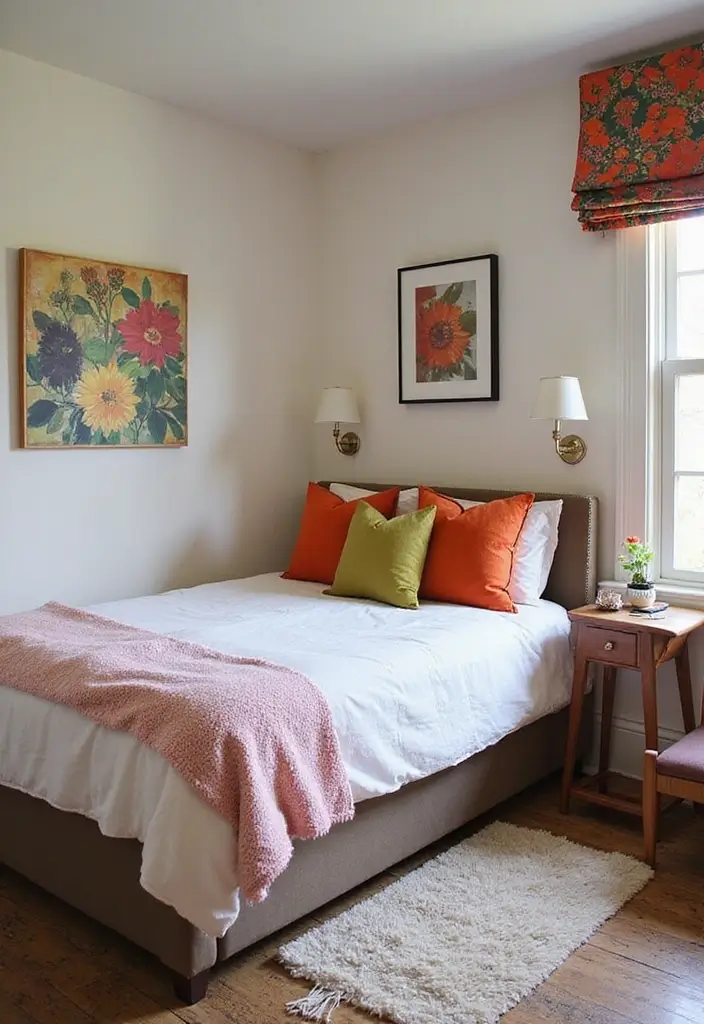
A small bedroom can feel tight. Color can wake it up without crowding the space. Use color in smart spots to keep it airy.
Start with a calm base. Paint walls in a shade or keep them white. You can keep the walls neutral while you add color in small ways. Let pieces stay quiet and let color live in textiles and art.
Here is why color works in small rooms. It draws the eye to cushions, pillows, and prints instead of walls.
Suggestions: Keep a limited color palette to stay cohesive.
– Pick 2 or 3 accent colors and repeat them in pillows and art.
– Add color with textiles like pillows, a quilt, or a rug.
– Choose artwork and bedding that show your taste.
– Use neutral walls and clean lines so color has room to breathe.
– Rotate accessories with the seasons.
Next steps: pick a palette, gather pieces, swap covers seasonally.
Texture adds depth without more color.
Try a cotton throw, a wool blanket, or a linen curtain in your colors.
For practicality, pick washable fabrics and easy-to-clean prints.
Shop smart and swap looks every few months. Your room stays fresh.
Try it.
14. Desk Nooks in Alcoves
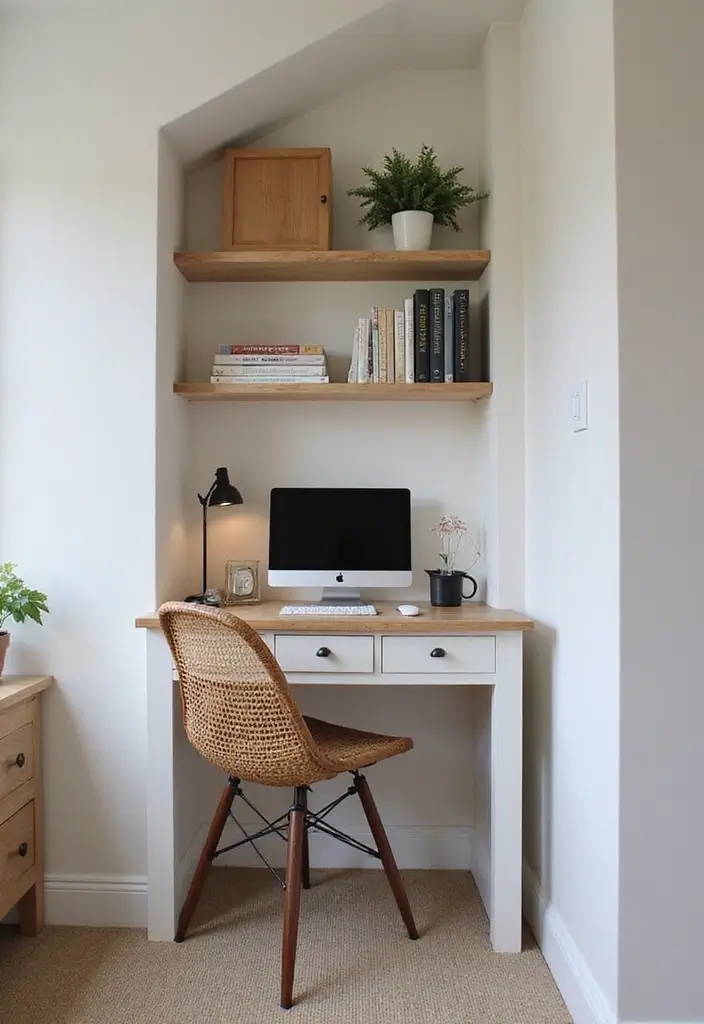
If you have an alcove in your bedroom, you can turn it into a cozy desk nook that adds work space without crowding the room. Here’s how to do it well.
– Right-size the desk: measure the alcove and pick a desk that fits with room to spare for your knees. A slim, wall-mounted unit or a compact desk with a small drawer works best.
– Add shelves above: install slim shelves so you can store notebooks, a few books, and a tiny plant. This keeps the desk clear for work and adds texture to the wall.
– Set the right height: adjust the desk so your elbows sit at a comfortable 90 degrees. Pair it with a chair that supports your back and feet flat on the floor.
– Light and openness: choose light colors for the walls or add a mirror on the alcove wall. Light hues and a reflection bounce make the space feel larger.
– Hide the cables: run cords through a grommet or use a small cable tray. A tidy setup keeps distractions away and looks cleaner.
– Choose a compact chair: pick a slim chair or a foldable one you can tuck under the desk when you’re not using it.
– Add finishing touches: a small lamp, a single framed photo, and a tiny plant can make the nook inviting without clutter.
– Quick upgrade ideas: install a fold-down desk if space is tight, or use a rolling cart that slides under the desk for extra supplies.
Next steps: measure, pick a desk that fits, and start with one shelf. You’ll gain a useful work zone without losing bedroom calm.
Transform your alcove into a cozy desk nook! With the right-sized desk and some chic shelves, you can maximize your space and boost your productivity without sacrificing style.
15. Built-in Bedside Tables
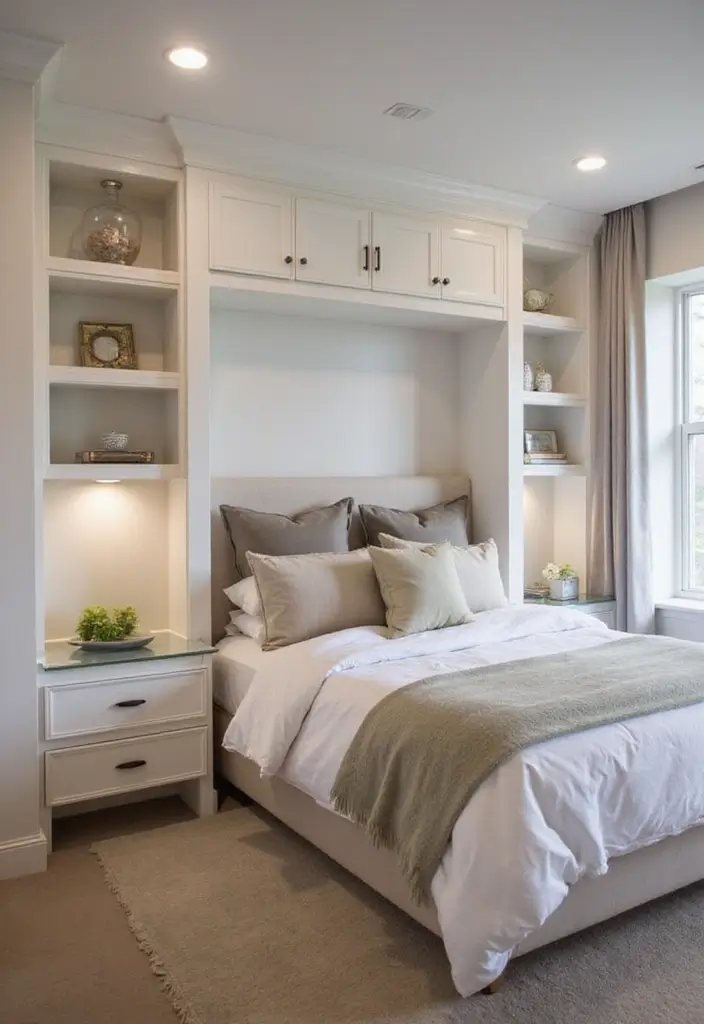
If your room feels tight, built-in bedside tables can change that. They save floor space by joining the bed area to the wall. They stay out of the way when you move around.
Here is why they work. They fit your bed snugly and give you a surface for a lamp, water, or a book. You can add storage that you actually use, not a big, bulky piece.
Suggestions: Use the same color as your walls for the tables to blend with the room and make it look bigger. Add a slim reading light above the table so you can read without piling on lamps.
– Open shelves keep quick items within reach.
– Drawers hide chargers, earbuds, and small items.
– Hidden compartments store remotes, medicines, or a notebook.
Next steps include planning depth and height. A common depth is 12 to 16 inches. Make sure the top aligns with the bed for easy reach. Pick materials that fit your budget. Plywood with a wood veneer or a solid wood look works well. Choose soft-close drawers for a quiet, smooth feel. Finish with a coat that matches your wall color or bed frame.
16. Lighter Window Treatments

Are you trying to make a small bedroom feel bigger? The look of your windows can make a big difference. Heavy drapes soak up light and push walls in. Light window treatments lift the room instead.
What to pick
– Sheer curtains in voile or cotton blends give air and visibility.
– Light-colored blinds or shade fabrics keep the view open but offer privacy.
Here is why it works
Natural light bounces around. Soft fabrics reflect a gentle glow. A bright window makes corners feel farther apart and walls seem higher. Even on a cloudy day, the space reads lighter and more inviting.
Next steps for a modern, airy setup
– Choose breathable fabrics: voile, linen blends, or cotton sheers in ivory, white, or pale gray.
– Hang curtains close to the ceiling and extend the rod beyond the frame to add height and width.
– Layer shades with sheer panels for adjustable brightness without heaviness.
Maintenance and limits
– Pick easy-care fabrics; light treatments clean fast.
– Privacy can be solved with the right layer without losing light.
End result
A brighter window area makes the whole room feel bigger, calmer, and more welcoming. Try this in minutes now.
17. Personalized Gallery Walls
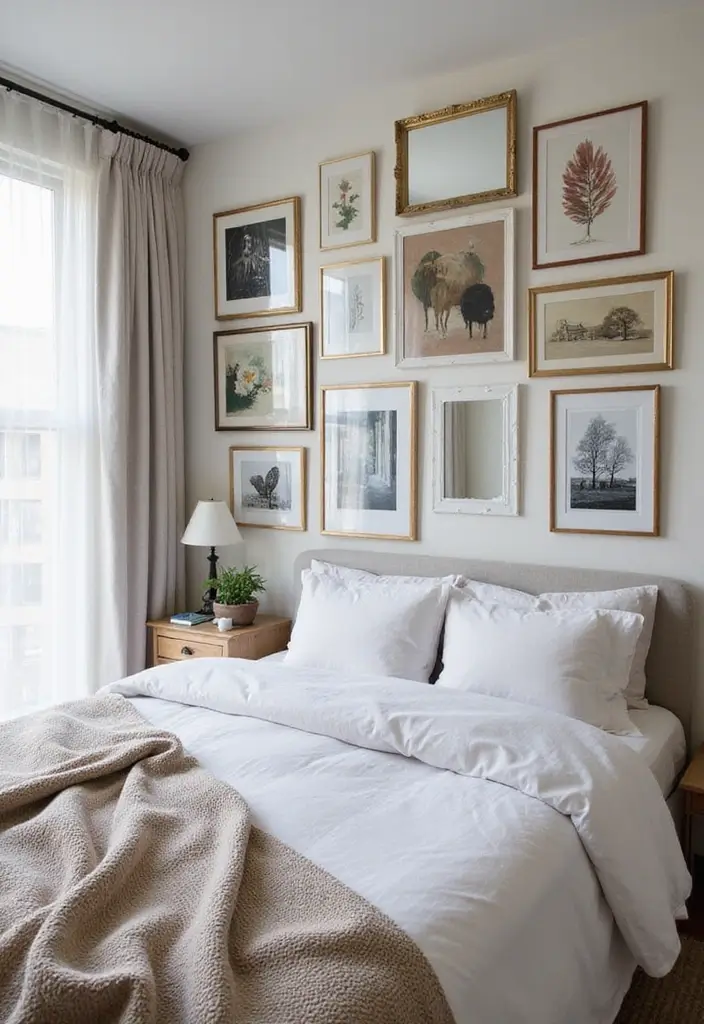
If your small bedroom feels cramped, a personalized gallery wall can bring color and life without taking up floor space. Mix framed art, candid photos, and a couple of mirrors to keep the wall lively. A tidy arrangement helps the room feel open instead of crowded.
This setup nudges the eye upward, adding height to the room. To keep it calm, choose frames that share a color family or style. For example, all black frames with white mats, or warm wood frames in the same finish, create a cohesive look that still carries your personality.
Here is how to build your gallery wall:
– What to gather Choose 8 to 12 pieces: prints, photos, and one or two small mirrors.
– Plan the layout Lay items on the floor or make paper templates to test spacing.
– Hang at eye level Center the main piece about 57 inches from the floor.
– Spacing and cohesion Keep gaps around 2 to 4 inches for a tidy look.
– Mounting tips Use lightweight frames for easy adjustments.
– Lighting Add a slim plug-in light or warm LEDs to reduce glare.
Next steps: hang, step back, and tweak. Keep painter’s tape and a small level on hand for quick fixes.
18. Utilizing Corner Spaces
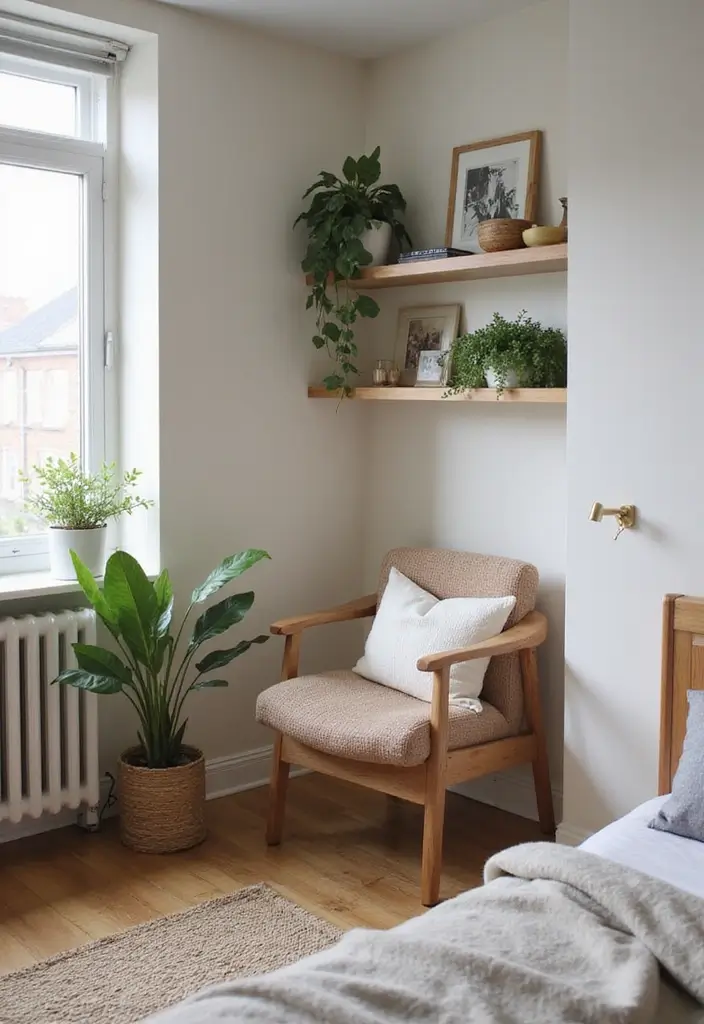
Your small bedroom has corners that often stay empty. That space can be your best tool if you use it the right way. Here is a simple plan to turn every corner into a useful zone.
Think about a corner shelf or a slim armchair. A wall-mounted shelf keeps items off the floor and adds storage at the same time. You can reach books, chargers, or outfits without moving around too much.
Add a tall plant or a small lamp in the corner. Plants bring color and life, while soft light reduces shadows and makes the room feel bigger.
For style, pick clean lines and light colors. A light wood shelf or a white metal frame blends with most beds and curtains.
Tips:
– Let corner shelves draw the eye upward to give a sense of height.
– A cozy corner seat with hidden storage hides extra linens or books out of sight.
In addition, try a corner bench or ottoman. It gives you a seat and a place to stash items like spare sheets, blankets, or magazines.
Next steps: measure the corner, pick one idea to start, and gather a slim shelf, plant, or chair. Mount or place it, then adjust lighting and textiles to taste.
19. Minimalistic Approach to Decor
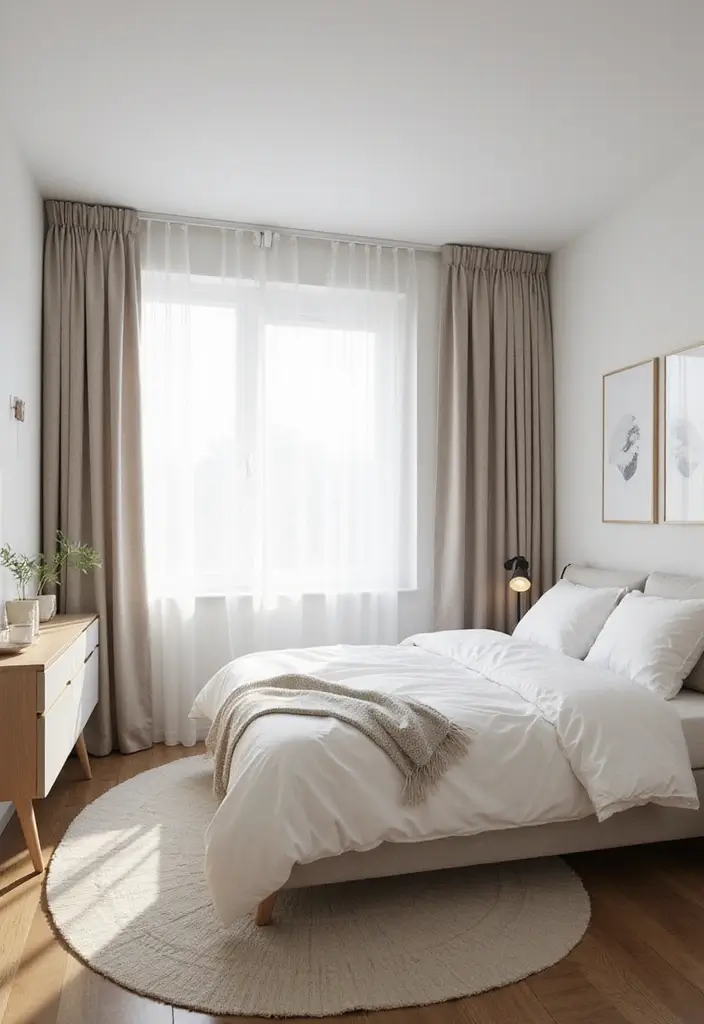
Is your small bedroom crowded and hard to use? Minimalist decor can free space and calm your mind. It lowers clutter and helps you feel more open. You sleep better when the room stays simple. Here is why this approach works.
Suggestions: Keep only items you truly love and use. Then plan each piece to serve more than one purpose.
– Declutter first by removing items you never touch.
– Pick furniture with clean lines and a slim profile.
– Use a limited color palette: whites, beiges, and soft grays.
– Choose multifunctional pieces such as a bed with built-in drawers or a storage ottoman.
– Keep surfaces clear with storage boxes and hidden cords.
– Let light flow with sheer curtains or a wall mirror that reflects brightness.
– Create a single focal point with a simple, quiet piece of art.
– Plan your layout for easy movement by keeping walkways open.
– Choose wall-mounted shelves instead of tall bookcases.
– Pick a bed with built-in storage to hide extra bedding.
– Add a slim mirror to bounce light around the room.
– Choose light wood, glass, or acrylic for an airy feel.
– Keep patterns simple on textiles like bedding to avoid busy looks.
– Choose durable fabrics that wear well in low light.
– Practice cord management to keep outlets tidy.
– Use a small area rug that doesn’t crowd the space.
20. Under-Bed Storage Options
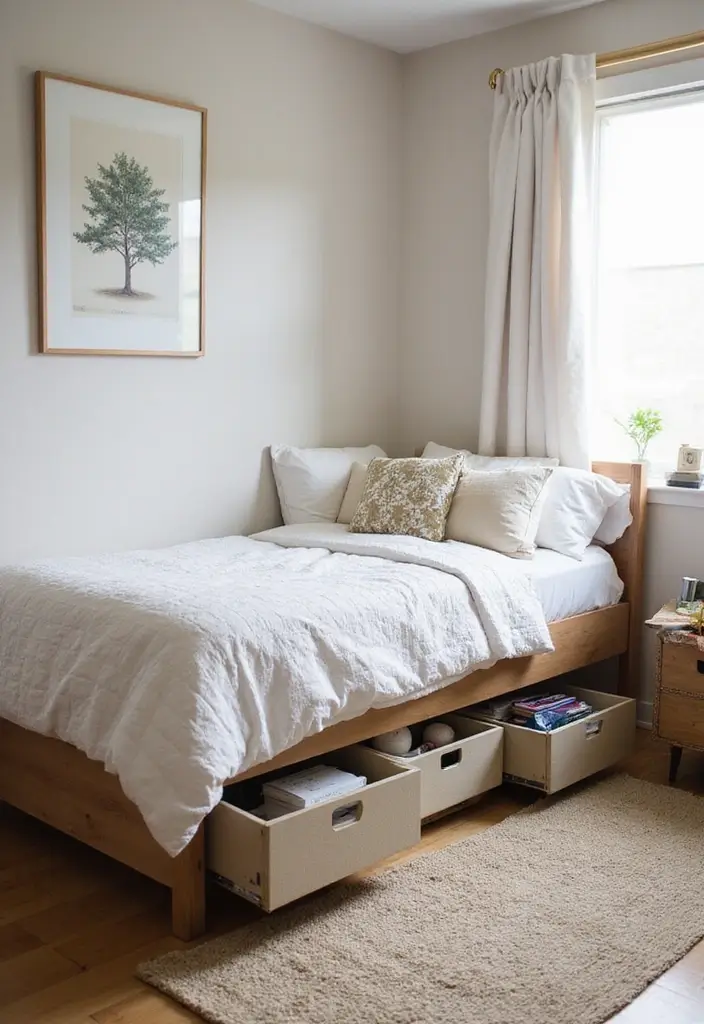
If a small bedroom feels crowded, under-bed storage can free floor space. It hides items in plain sight and keeps daily essentials within reach.
Here is why this approach works. The space under your bed often sits empty. With the right containers, you turn that gap into real storage that won’t clutter your room.
Tips:
– Choose low-profile bins or rolling drawers that fit the bed’s clearance and still slide smoothly.
– Pick clear plastic bins for quick visibility, or fabric bins that match your room’s color and style.
– Store off-season clothes, extra blankets, or spare linens here to free up closet space.
– Use front tags or color labels so you can see what’s inside at a glance.
– Rotate items every few months so the stash stays fresh and clutter stays in check.
– Put heavier boxes toward the center of the under-bed space to keep the setup stable.
– Protect contents from dust with a light bed skirt or a breathable liner.
– If your bed sits high, you can add shallow rolling drawers that glide out easily.
– Measure the bed height and the space to the floor before you buy anything.
Next steps: pick a container type, add labels, and schedule a 15-minute monthly check to keep things tidy.
21. Chic Bed Frames that Save Space

If your bedroom feels small, the right bed frame can make it feel bigger. The trick is to choose a design that stores stuff and stays light visually. Here is why space-saving frames matter and how to pick them.
– Platform beds with built-in drawers: These frames hide blankets, sheets, and seasonal clothes in drawers under the mattress line. You keep clutter tucked away and free up dresser space.
– Low-profile frames: A bed with a slim base and a flat headboard keeps sightlines open. You gain height without crowding the floor.
– Light materials and finishes: Pick pale wood, white, or matte gray. Lighter tones bounce light around and stop the room from feeling heavy.
– Smart under-bed storage: Look for easy-slide drawers or lift-top bases. Use slim bins or fabric organizers to store extras without blocking air flow.
– Coordinate your bedding: Match sheets and a duvet to the frame. A cohesive look feels calmer and makes the space feel larger.
Next steps: choose one or two ideas to try this week. Small changes can make a big difference in how your room feels.
22. Using Wall Art to Direct Attention
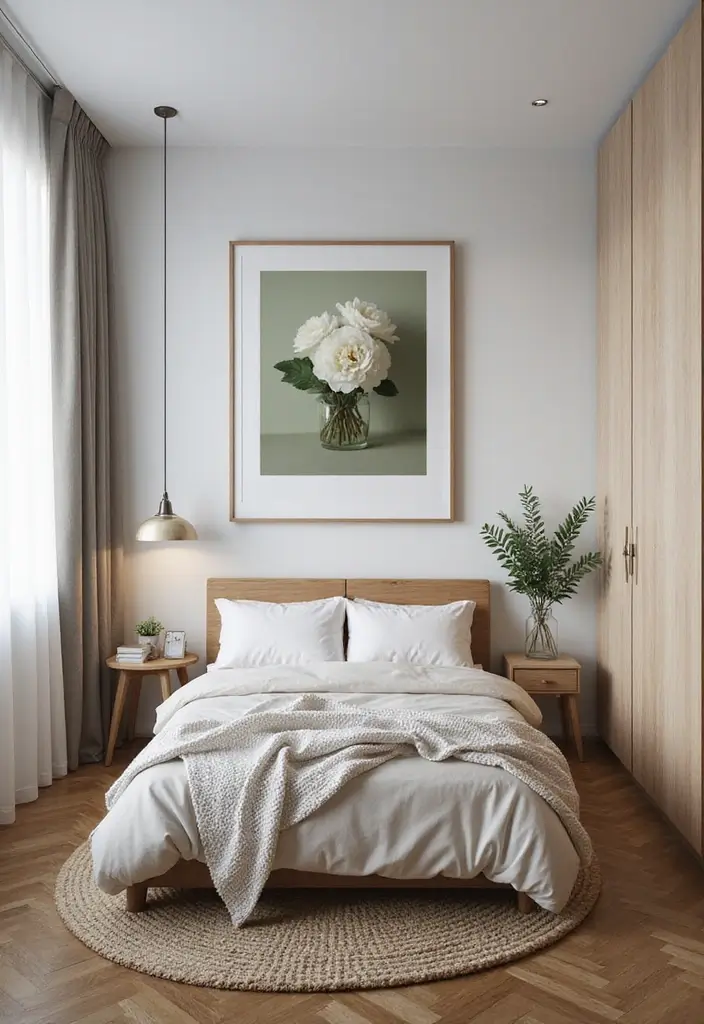
If a small room feels crowded, wall art can steer the eye and make the space feel larger. A bold piece acts as a starting point for the room’s look and keeps the wall clear of clutter.
– Choose one large piece that covers more wall space. This draws attention to a single spot, not a crowd of small items. A big canvas, a tall poster, or a framed print can do the job.
– Keep the frame simple. A slim or neutral frame lets the art stand out without shouting. This helps the wall feel calmer and the room feel bigger.
– Pick art you love and that fits your colors. Art adds character and depth when it matches your style and your walls. It feels personal, not generic.
Here is why this works: your eye rests on a single focal point. The rest of the room stays quiet, so the space breathes. To use this well, hang art at eye level and center it on the wall you want to brighten. If the wall is above a bed or sofa, place the art so the midpoint sits about 57 inches from the floor.
Next steps: measure wall space, choose a large piece, and plan where to hang it. For small rooms, one well-chosen piece beats many small items every time. Keep lighting in mind; soft, even light makes colors pop without glare. If you try, you’ll feel the room open up.
23. A Cozy Reading Nook

If you love to read but your bedroom is tight, you can still build a cozy reading nook. It gives you a quiet corner to unwind with a book today.
– Chair choice Pick a chair that fits the room. Look for a compact, sturdy seat with good back support.
– Smart placement Place it by a window. Natural light helps your eyes and makes the space feel bigger.
– Convenient surface Add a small side table for tea, glasses, and your current book. It should be easy to reach from the chair.
– Lighting that works Set up soft lighting. A warm lamp with an adjustable arm directs light right onto your page.
– Textile comfort Layer textiles. Leave a soft throw on the chair and a few plump pillows for warmth and comfort.
– Quick storage Add easy access storage. A slim bookshelf or wall shelves nearby keeps your favorite reads within arm reach.
– Space defined Define the space with a rug. A small rug adds warmth and helps the nook feel complete.
– Personal touch Personalize it. A plant or photo and a tiny tray for keys keep the room calm.
Next steps: keep the nook tidy, rotate books, and adjust the chair position until it feels right.
24. Utilizing Natural Light
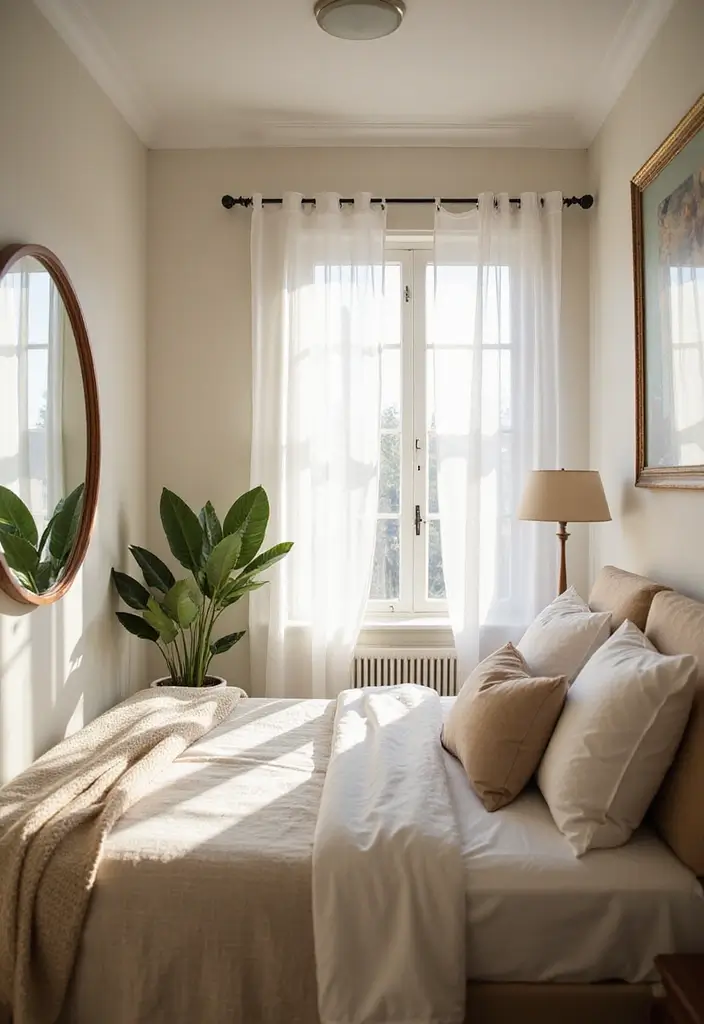
Are you trying to make a small bedroom feel bigger? Natural light can do most of the work. It makes walls seem farther apart and the room feel more alive. You wake to a space that looks tidy and inviting. Here is why daylight matters in a compact room.
Tips for daylight in a small room
– Place mirrors opposite windows so sunlight bounces around the room.
– Choose sheer curtains that let in soft daylight.
– Keep window sills clear of clutter.
– Move large furniture away from windows to avoid blocking the glow.
– Paint walls in light colors and use glossy surfaces to reflect light.
– Add glass or metal accents like a lamp with a chrome base to catch rays.
– If possible, add a skylight or a light tube to bring in daytime from above.
– In the evenings, use a warm lamp near the bed to mimic sunset glow.
Start with one change, then add another. Test how the room feels with the same light level at different times of day. These tweaks are simple yet powerful for a small space.
Try this in stages. Move a mirror first, then open curtains fully for a week. Notice how the room shifts from morning light to afternoon sun. Small shifts add up and cost little to change.
25. Personal Touches with Accessories
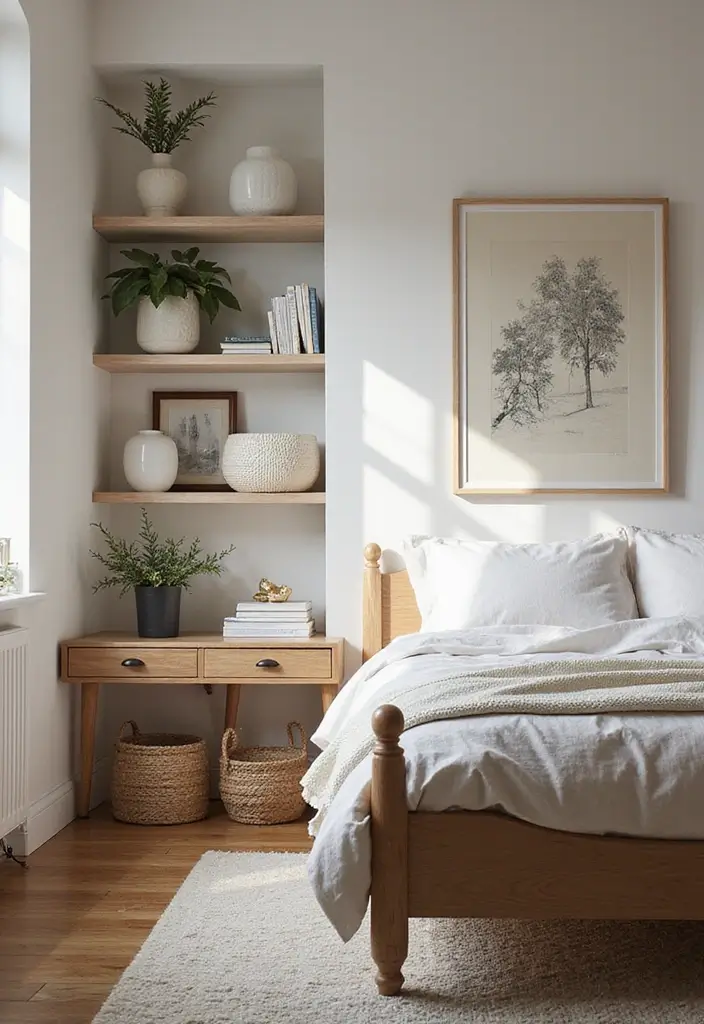
A small bedroom can feel crowded fast. Personal touches make it cozy without crowding. You can add life with simple accents that stay tidy. Here are easy ideas you can try this week.
– Pick a few favorites. Pick 2 or 3 items you truly love. Let them be the room’s quiet focus on display.
– Use decorative baskets. They hide clutter and keep surfaces clean. Slide one under the bed or on a shelf for easy access.
– Display keepsakes. Show personal mementos in a small group. A photo, a shell, or a keepsake tells your story. Keep them on a shallow tray to stay organized.
– Mix textures and color. Combine wood, ceramic, glass, and fabric. Let them share a common color so the look feels tied together.
– Rotate seasonally. Swap in new pieces as the seasons shift. A sprig of greenery or a bold accent can refresh the vibe.
– Think about placement. Place one item on the nightstand. Add a compact sculpture on a shelf. Use a small tray on the dresser to corral bits. Group items in odd numbers for a natural feel.
– Keep it practical. Dust regularly. Clear surfaces weekly. Let a tray hold keys and chargers to keep surfaces calm.
26. Cozy Throw Pillows and Blankets
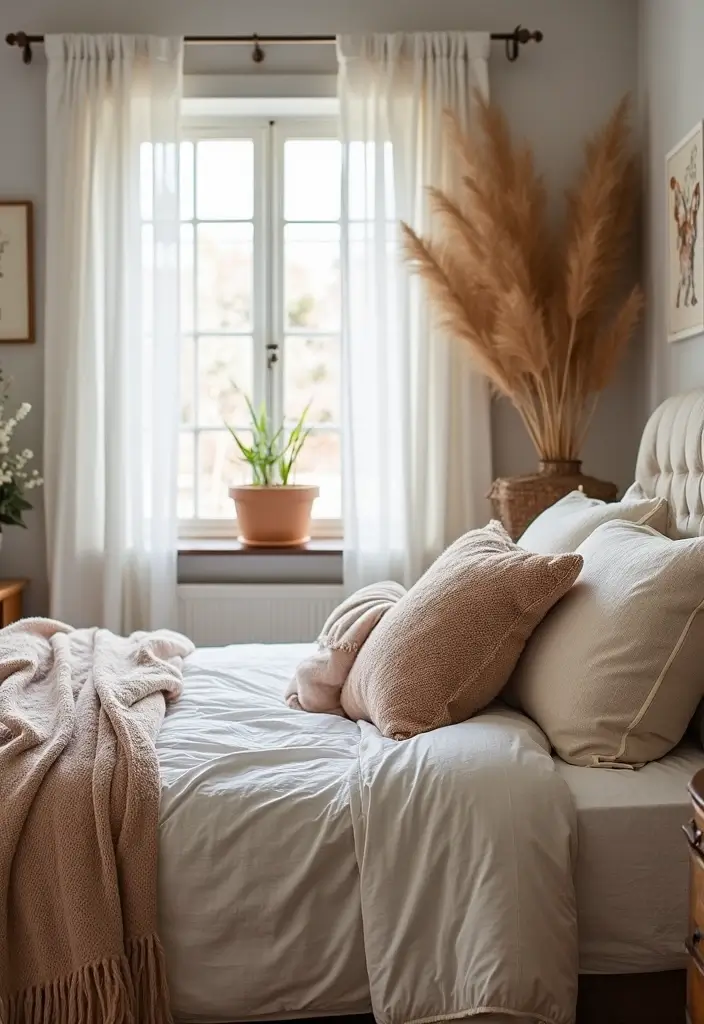
Your small bedroom can feel warm and inviting with a smart mix of throw pillows and blankets. Here is why this works. You layer color and texture to add depth without crowding the space. The goal is to touch the room with warmth, not to fill it with stuff.
Tips for cozy pillows and throws
– Start with a simple base color from your room’s palette to guide all choices.
– Mix textures like knit, cotton, velvet, and faux fur to add depth without clutter.
– Use a balanced layering scheme: one large pillow, one medium, and a slim lumbar for shape.
– Keep the total pillow count to 3-4 so the bed stays easy to use.
– Pick lightweight blankets and throws you can drape or fold for quick changes.
– Choose colors and patterns that echo your rug or art for a cohesive look.
– Swap pillow covers seasonally to refresh the room without buying new items.
– Care and storage: wash covers regularly and store extra pillows in a bin under the bed.
Next steps: try this setup, see how it feels, and adjust the mix until it fits your space.
27. Color-Coded Storage Solutions
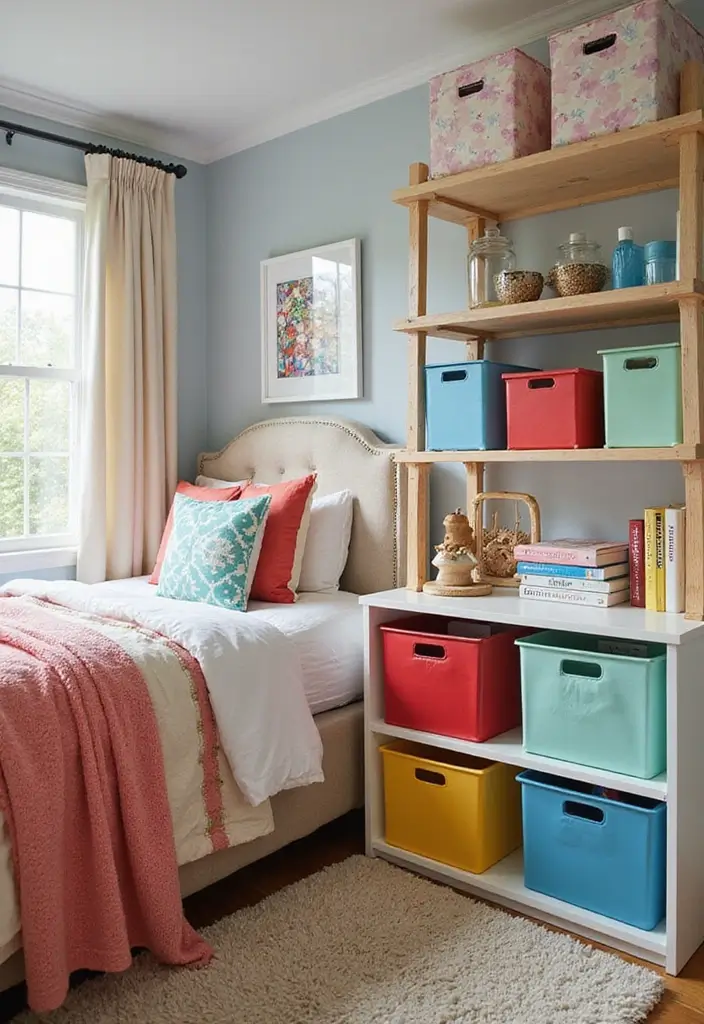
Staying organized in a small bedroom can feel hard. Color coded storage helps fix that. When you see a color path for items, you spend less time searching and more time relaxing. This setup keeps surfaces clear and the room feeling bigger. Here is why it works: colors help the brain group items fast.
Next steps to make color coded storage work in a small room.
– Colors to choose: Decide 2 to 3 colors that you want to match your duvet, walls, and floor.
– Bins and visibility: Choose storage bins in those colors and add bins so you can see contents.
– Color categories: Assign each color to a category, like blue for tech cords, green for clothing, pink for makeup.
– Placement: Place bins where you reach them easily, like a low shelf or under the bed.
– Labels: Label each bin with a color tag or simple icon and keep a tiny color map.
– Materials: Opt for a mix of fabric and plastic bins to balance looks and durability.
Do a monthly check to swap items that drift from their color zones too. Keep the color map visible so you stay on track. Small bins with lids help dust and stash away things you rarely use.
28. Simple Desk Organization
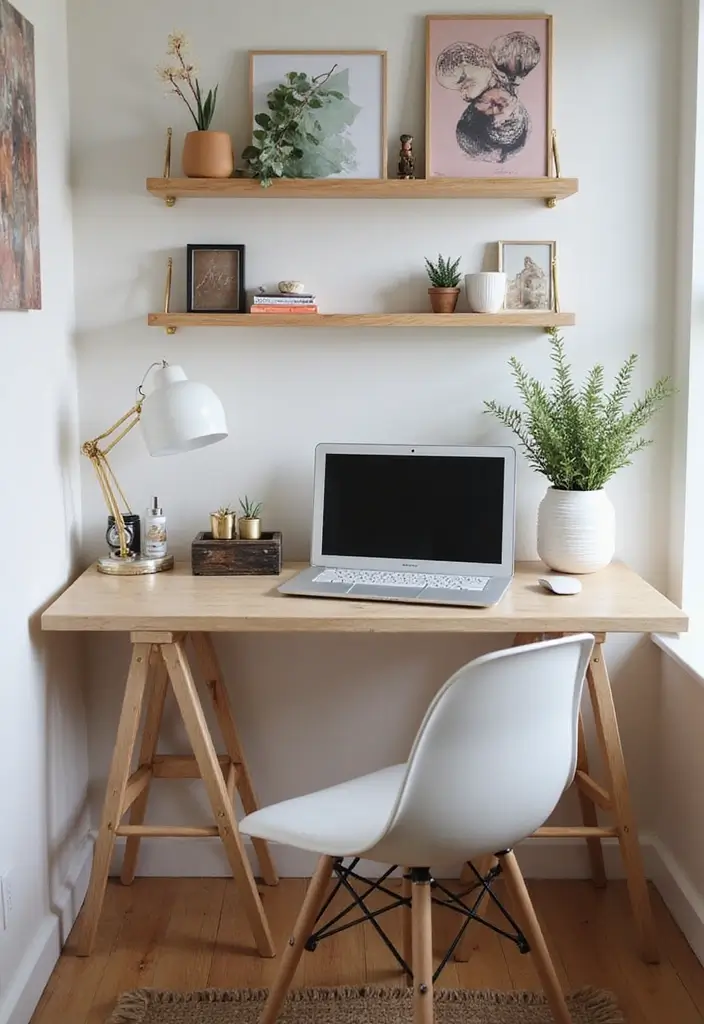
Is your small bedroom desk piling up with pens, cables, and paper? Here is why a tidy setup makes a big difference: it keeps you focused and frees space for a clear mind.
– Create a simple workspace zone: keep only what you use daily on the desk. Choose slim, wood or metal organizers that fit well.
– Use trays and drawer organizers: they hold loose items like rubber bands, clips, and paper. This stops loose clutter from spreading.
– Put cords in check: a small cable box or clips keep cords off the surface. Decide one charging spot so you know where things go.
– Add a touch of life: a tiny plant or a photo in a slim frame makes the desk feel welcoming, not cold.
– Keep surfaces clear most days: a quick nightly wipe adds a sense of space in the room for better focus.
Unique Insight: Choose organizers that match your style and desk color. A light wood or white tone blends with many small rooms.
Next steps: test a simple kit for a week. If it works, keep it. If not, swap trays or move items to a drawer. With a calm desk, your small bedroom will feel bigger and more usable.
29. Strategically Placed Artwork
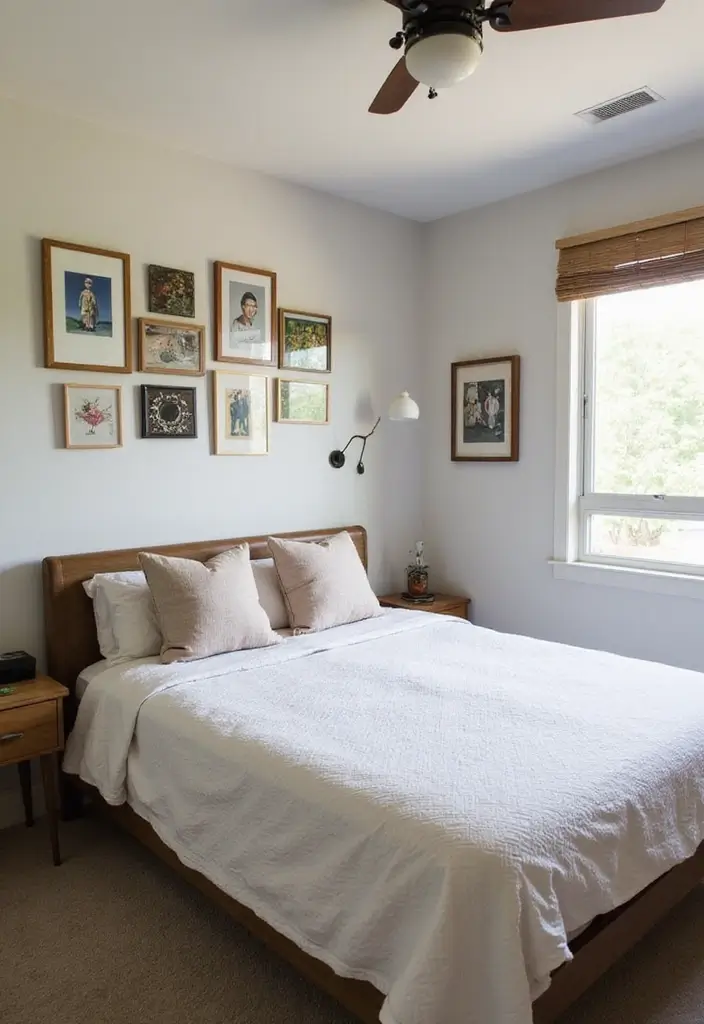
You want a small bedroom to feel bigger. The right artwork can do that. It adds depth and guides the eye where you want it.
– Pick a focal piece: A single large canvas or framed print above the bed acts as the room’s center. Choose a color that matches your sheets for calm, or a bold tone for energy.
– Keep the frames cohesive: Use frames in the same finish or color range. A unified look makes a small wall feel tidy.
– Test the layout first: Tape paper cutouts to the wall or lay out prints on the floor. Try a centered piece above the bed, or a clean line of three on a long wall.
– Placement tips: A big piece over the bed draws the eye up and adds height. A long horizontal piece on a bare wall adds width.
Next steps: measure the wall space, pick art you love, and hang only after you’re sure of the arrangement. If you love smaller prints, arrange 3–4 pieces with even spacing to create a compact gallery.
Think through a few practical details as you plan. Start with the wall you notice first when you walk in. Make sure the art can be hung safely. Heavy pieces should go on studs, not drywall alone. Keep lighting simple so the art can shine without glare.
30. Seasonal Decor Change-Ups
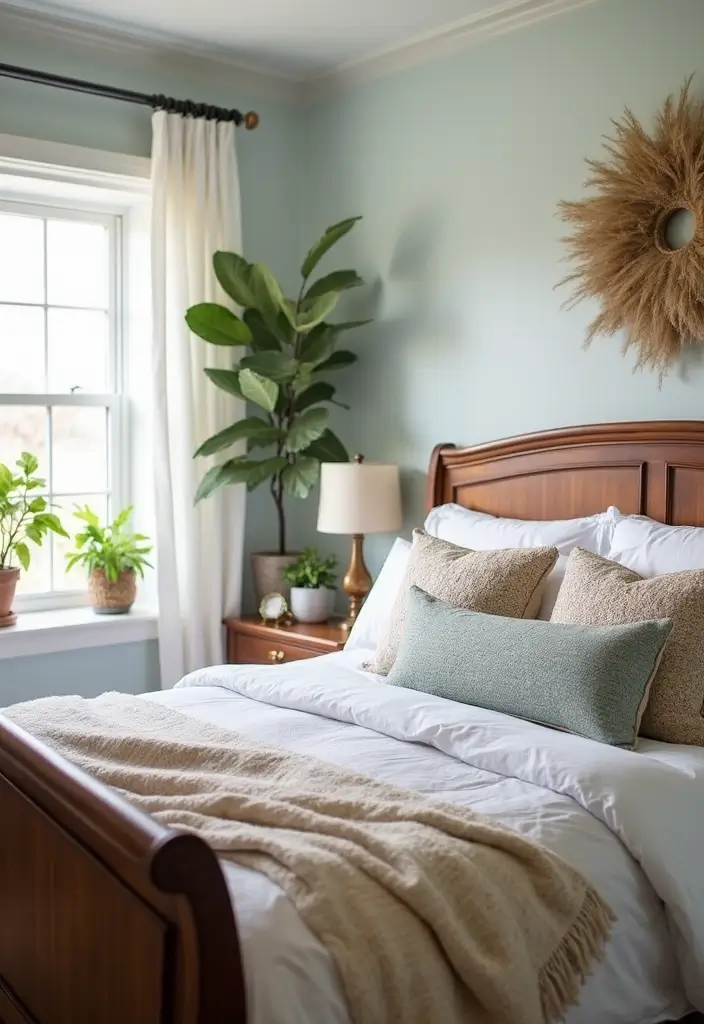
Seasonal decor change-ups help a small bedroom stay fresh without big resets. You can swap bedding, throws, and small accents as the year turns. This keeps the look personal without lasting changes.
Here is why this works in a compact space. Simple swaps add character without crowding the room. They are quick to do and easy on the wallet. You can create four distinct moods with little effort.
– Keep 3 core pieces you switch with the seasons.
– Rotate bedding with the season, swapping duvet covers and sheets.
– Use textures that fit the season, such as cotton in warm months and flannel in cold months.
– Update small items like cushions, throws, and lamp shades.
– Ground the room with 1 or 2 anchor pieces kept in place.
Tips: Start with a few anchor pieces and swap smaller accents to refresh the space on a budget.
Next steps. Plan your swaps for the coming season. Make a quick shopping list for affordable textures and colors. Set a date to do the switch and enjoy a new look in minutes.
Seasonal palettes make this easier. For spring, try light greens and pale blues. In summer, keep it airy with whites and natural fabrics. Fall brings warm rust and olive tones. Winter can lean toward navy and soft gray. Use these ideas as a guide, not a rule, to keep your bedroom feeling new all year.
Conclusion
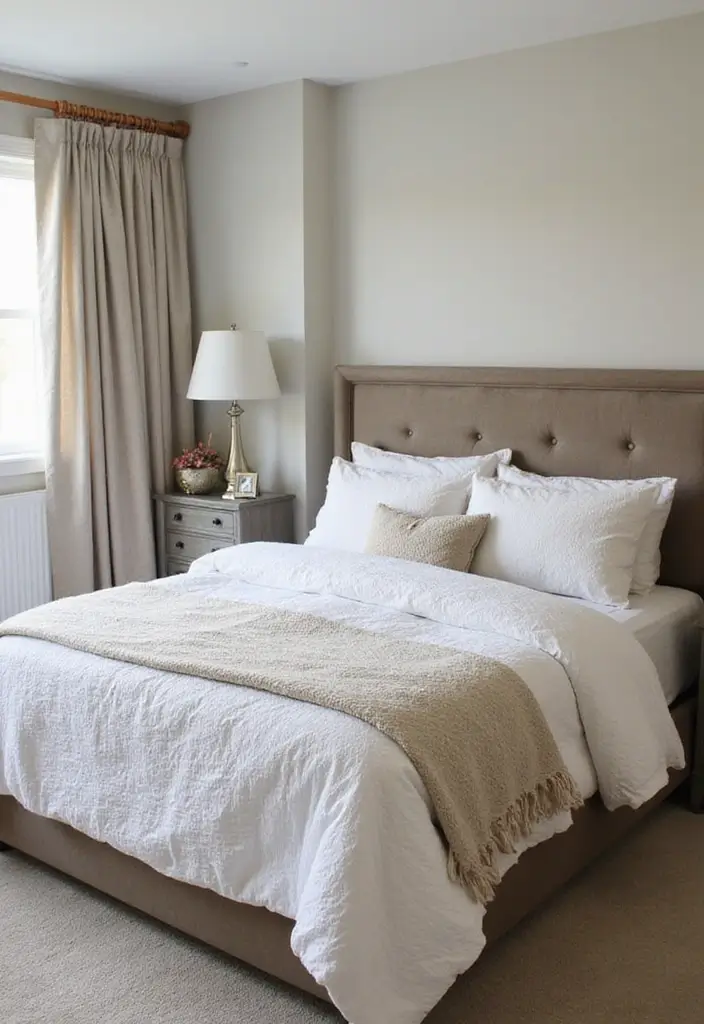
Transforming a small bedroom into a spacious retreat is all about clever design choices and thoughtful decor.
Incorporating smart storage, light colors, and multifunctional furniture can truly maximize your space while keeping it stylish and cozy.
With these 30 bedroom set up ideas, your small room can feel big, inviting, and uniquely yours.
Frequently Asked Questions
What are some effective small bedroom decor tips to make my space feel larger?
To create a more spacious feel in your small bedroom, opt for light colors on your walls and furnishings. Soft whites and pastels can significantly enhance the brightness and openness of the room.
Incorporating mirrors strategically can also create an illusion of depth, making the area appear larger. Additionally, consider using floating shelves for storage, as they provide functionality without taking up valuable floor space.
How can I maximize vertical space in my small bedroom?
Maximizing vertical space is key in small bedrooms! Utilize tall, slim bookcases for storage, which keep your items off the floor and add height to the room.
Also, look for wall-mounted lighting solutions to free up surface space on your nightstand. Vertical plants or hanging planters can add life and color without occupying precious ground space.
What types of space-saving furniture work best for a small bedroom?
When it comes to space-saving furniture, multi-functional pieces are your best friends. Look for beds with under-bed storage or compact desks that fit snugly in corners.
Consider using built-in bedside tables that save floor space by attaching directly to the wall. These clever designs help maintain a tidy look while maximizing your small bedroom’s functionality.
How can I create a cozy bedroom layout in a small space?
Creating a cozy layout in a small bedroom is all about the right arrangement. Use rugs to define different zones, such as a reading nook or workspace, to give the illusion of separate areas.
Layering textures with throw pillows, blankets, and soft rugs can add warmth and depth without overcrowding your space. Remember, the goal is to make your bedroom inviting and relaxing!
What are some minimalist bedroom design ideas for small spaces?
For a minimalist bedroom design, focus on keeping decor simple and functional. Stick to a calm color palette with few bold accents to maintain an airy feel.
Choose furniture that serves more than one purpose, like a bed with built-in storage, and limit accessories to a few personal items that bring you joy. This approach not only maximizes space but also creates a serene and uncluttered environment.
Related Topics
home decor
small bedroom decor
space-saving furniture
minimalist bedroom design
vertical storage
cozy layouts
multifunctional ideas
DIY organization
light color schemes
budget friendly
beginner tips
seasonal decor

